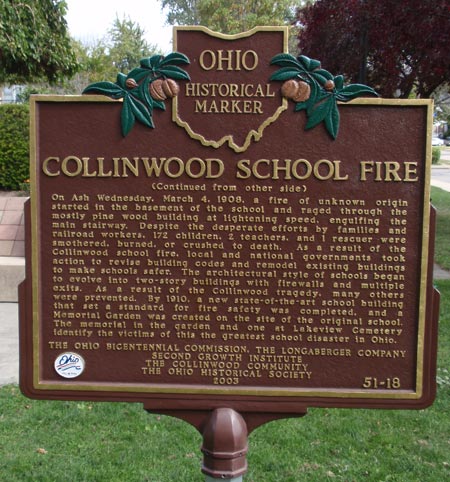The Collinwood School Fire (also known as the Lake View School Fire) occurred onAsh Wednesday, March 4, 1908. It was one of the deadliest disasters of its type with 172 students, two teachers and one rescuer killed.
The Village of Collinwood was originally a part of Euclid Township of the Western Reserve and named after the death of railroad chief engineer Charles Collins in 1876. Originally known as "Frogsville," the population of Collinwood dramatically increased in the 1870s, due partly to repair roundhouses of the Lake Shore & Michigan Southern Railroad. By 1901, the Village has grown to 7,500, and as a result, the schoolhouse, which once housed 200 students and four classrooms, had been enlarged twice to house 350 students in eight classrooms. Constructed in 1901, the Lakeview School was the site of a tragedy that reverberated across the nation and around the world.

On Ash Wednesday, March 4, 1908, a fire of unknown origin started in the basement of the school and raged through the mostly pine wood building at lightening speed, engulfing the main stairway. Despite the desperate efforts by families and railroad workers, 172 children, 2 teachers, and 1 rescuer were smothered, burned, or crushed to death.
As a result of the Collinwood school fire, local and national governments took action to revise building codes and remodel existing buildings to make schools safer. The architectural style of schools began to evolve into two-story buildings with firewalls and multiple exits. As a result of the Collinwood tragedy, many others were prevented.
By 1910, a new state-of-the-art school building that set a standard for fire safety was completed, and a Memorial Garden was created on the site of the original school. The memorial in the garden and one at Lakeview Cemetery identify the victims of this the greatest school disaster in Ohio.
The final casualty of the fire was the independence of the Collinwood community itself. Unable to sufficiently guarantee fire safety resources for its residents, voters approved an annexation of Collinwood into Cleveland within two years of the fire.